Spray-Dried Jaboticaba Powder as Food Resource
Abstract
1. Introduction
2. Materials and Methods
2.1. Raw Material
2.2. Experimental Apparatus and Procedure
2.3. Experimental Design
2.4. Moisture Analysis
2.5. Drying Yield (DY)
2.6. Analysis of Bioactive Compounds
2.6.1. Total Phenolic Content (TPC)
2.6.2. Total Flavonoid Content (TFC)
2.6.3. Acidity or Citric Acid Content (CA)
2.6.4. Ascorbic Acid Content (AA)
2.7. Statistical Analysis
3. Results and Discussion
3.1. Drying Performance
3.2. Bioactive Compounds
3.2.1. Total Phenolic Content (TPC)
3.2.2. Total Flavonoid Content (TFC)
3.2.3. Acidity (CA)
3.2.4. Ascorbic Acid Content (AA)
3.3. Multi-Response Optimization
4. Conclusions and Recommendations
Author Contributions
Funding
Data Availability Statement
Acknowledgments
Conflicts of Interest
References
- Wu, S.-B.; Long, C.; Kennelly, E.J. Phytochemistry and health benefits of jaboticaba, an emerging fruit crop from Brazil. Food Res. Int. 2013, 54, 148–159. [Google Scholar] [CrossRef]
- Barroso, T.; Sganzerla, W.; Rosa, R.; Castro, L.; Maciel-Silva, F.; Rostagno, M.; Forster-Carneiro, T. Semi-continuous flow-through hydrothermal pretreatment for the recovery of bioproducts from jabuticaba (Myrciaria cauliflora) agro-industrial by-product. Food Res. Int. 2022, 158, 111547. [Google Scholar] [CrossRef] [PubMed]
- Lima, A.J.B.; Corrêa, A.D.; Dantas-Barros, A.M.; Nelson, D.L.; Amorim, A.C.L. Sugars, organic acids, minerals and lipis in jabuticaba. Rev. Bras. Frutic. 2011, 33, 540–550. [Google Scholar] [CrossRef]
- Inada, K.O.P.; Leite, I.B.; Martins, A.B.N.; Fialho, E.; Tomás-Barberán, F.A.; Perrone, D.; Monteiro, M. Jaboticaba berry: A comprehensive review on its polyphenol composition, health effects, metabolism, and the development of food products. Food Res. Int. 2021, 147, 110518. [Google Scholar] [CrossRef] [PubMed]
- Geraldi, M.V.; Souza, A.C.; Norde, M.M.; Berni, P.R.; Reguengo, L.M.; Geloneze, B.; Marostica, M.R. Jaboticaba peels improve postprandial glucose and inflammation: A randomized controlled trial in adults with metabolic syndrome. Nutr. Res. 2024, 125, 36–49. [Google Scholar] [CrossRef] [PubMed]
- Benvenutti, L.; Zielinkski, A.A.F.; Ferreira, S.R.S. Jaboticaba (Myrtaceae cauliflora) fruit and its by-products: Alternative sources for new foods and functional components. Trends Food Sci. Technol. 2021, 112, 118–136. [Google Scholar] [CrossRef]
- Henrique, C.M.; Prati, P.; Parisi, M.M.C.; Tavares, S. Determination of shelf life of jaboticaba’s fruits cv. ‘Sabará’. Braz. J. Biosyst. Eng. 2015, 9, 320–327. [Google Scholar] [CrossRef][Green Version]
- Barros, R.S.; Finger, F.L.; Magalhães, M.M. Changes in non-structural carbohydrates in developing fruit of Myrciaria jaboticaba. Sci. Hortic. 1996, 66, 209–215. [Google Scholar] [CrossRef]
- Nascimento, T.P.; Bettiol Neto, J.E.; Pereira, R.A.; Castro, I.A.; Chagas, E.A.; Lajolo, F.M.; Cordenunsi, B.R. Effect of thinning on flower and fruit and of edible coatings on postharvest quality of jaboticaba fruit stored at low temperature. Food Sci. Technol. 2013, 33, 424–433. [Google Scholar] [CrossRef]
- Silva, N.C.; Duarte, C.R.; Barrozo, M.A.S. Effects of dehydration methods on quality characteristics of yellow passion fruit coproducts. J. Sci. Food Agr. 2017, 97, 4750–4759. [Google Scholar] [CrossRef]
- Silva, D.I.S.; Souza, G.F.M.V.; Barrozo, M.A.S. Heat and mass transfer of fruit residues in a fixed bed dryer: Modeling and product quality. Dry. Technol. 2018, 37, 1321–1327. [Google Scholar] [CrossRef]
- Santos, R.L.; Brandão, R.J.; Nunes, G.; Duarte, C.R.; Barrozo, M.A.S. Analysis of particles collisions in a newly designed rotating dryer and its impact on the Camu-Camu (Myrciaria dubia) pulp drying. Dry. Technol. 2022, 40, 2034–2045. [Google Scholar] [CrossRef]
- Nogueira, G.D.R.; Silva, P.B.; Souza, G.F.M.V.; Duarte, C.R.; Barrozo, M.A.S. Vacuum Microwave Drying of Acerola Residue: Effects of Pre-treatment and Operating Variables on Main Bioactive Compounds. Waste Biomass Valori. 2023, 14, 1281–1292. [Google Scholar] [CrossRef]
- Inada, K.O.P.; Nunes, S.; Martínez-Blázquez, J.A.; Tomás-Barberán, F.A.; Perrone, D.; Monteiro, M. Effect of high hydrostatic pressure and drying methods on phenolic compounds profile of jabuticaba (Myrciaria jaboticaba) peel and seed. Food Chem. 2020, 309, 125794. [Google Scholar] [CrossRef]
- Chua, L.S.; Wahab, N.S.A. Drying Kinetic of Jaboticaba Berries and Natural Fermentation for Anthocyanin-Rich Fruit Vinegar. Foods 2023, 12, 65. [Google Scholar] [CrossRef]
- Leite, A.V.; Malta, L.G.; Riccio, M.F.; Eberlin, M.N.; Pastore, G.M.; Júnior, M.R.M. Antioxidant Potential of Rat Plasma by Administration of Freeze-Dried Jaboticaba Peel (Myrciaria jaboticaba Vell Berg). J. Agric. Food Chem. 2011, 59, 2277–2283. [Google Scholar] [CrossRef]
- Moura, M.S.; Costa, B.S.G.; Giaconia, M.A.; Andrade, R.R.; Braga, A.R.C.; Braga, M.B. Jaboticaba powders production by freeze-drying: Influence of octenyl succinic anhydride-modified starch concentrations over anthocyanins and physical properties. J. Food Process Eng. 2023, 46, e14256. [Google Scholar] [CrossRef]
- Nunes, L.P.; Ferrari, C.C.; Ito, D.; Souza, E.C.G.; Germer, S.P.M. Drum drying process of jabuticaba pulp using corn starch as an additive. Braz. J. Food Technol. 2020, 23, e2019166. [Google Scholar] [CrossRef]
- Ferreira, M.N. Study of Jaboticaba Drying (Pulp and Peel) Using the Foam Mat Technique. Master’s Dissertation, Food Science and Technology Course, Federal University of Goiás, Goiânia, GO, Brazil, 2017; 109p. Available online: https://repositorio.bc.ufg.br/tede/handle/tede/7962 (accessed on 7 May 2024).
- Shishir, M.R.I.; Chen, W. Trends of spray drying: A critical review on drying of fruit and vegetable juices. Trends Food Sci. Technol. 2017, 65, 49–67. [Google Scholar] [CrossRef]
- Avellone, G.; Salvo, A.; Costa, R.; Saija, E.; Bongiorno, D.; Di Stefano, V.; Calabrese, G.; Dugo, G. Investigation on the influence of spray-drying technology on the quality of Sicilian Nero d’Avola wines. Food Chem. 2018, 240, 222–230. [Google Scholar] [CrossRef]
- Fernandes, R.V.B.; Borges, S.V.; Botrel, D.A. Influence of spray drying operating conditions on microencapsulated rosemary essential oil properties. Food Sci. Technol. 2013, 33, 171–178. [Google Scholar] [CrossRef]
- Keshani, S.; Daud, W.R.W.; Nourozi, M.M.; Namvar, F.; Ghasemi, M. Spray drying: An overview on wall deposition, process and modeling. J. Food Eng. 2015, 146, 152–162. [Google Scholar] [CrossRef]
- Braga, V.; Guidi, L.R.; Santana, R.C.; Zotarelli, M.F. Production and characterization of pineapple-mint juice by spray drying. Powder Technol. 2020, 375, 409–419. [Google Scholar] [CrossRef]
- Quek, S.Y.; Chok, N.K.; Swedlung, P. The physicochemical properties of spray-dried watermelon powders. Chem. Eng. Process Process Intensif. 2007, 46, 386–392. [Google Scholar] [CrossRef]
- Tonon, R.V.; Brabet, C.; Hubinger, M. Influence of process conditions on the physicochemical properties of açai (Euterpe oleraceae Mart) powder produced by spray drying. J. Food Eng. 2008, 88, 411–418. [Google Scholar] [CrossRef]
- Muzaffar, K.; Kumar, P. Moisture sorption isotherms and storage study of spray dried tamarind pulp powder. Powder Technol. 2016, 291, 322–327. [Google Scholar] [CrossRef]
- Zotarelli, M.F.; Silva, V.M.; Durigon, A.; Hubinger, M.D.; Laurindo, J.B. Production of mango powder by spray drying and cast-tape drying. Powder Technol. 2017, 305, 447–454. [Google Scholar] [CrossRef]
- Ribeiro, C.M.C.M.; Magliano, L.C.S.A.; Costa, M.M.A.; Bezerra, T.K.A.; Silva, F.I.H.; Maciel, M.I.S. Optmization of the spray drying process conditions for acerola and seriguela juice mix. Food Sci. Technol. 2019, 39, 48–55. [Google Scholar] [CrossRef]
- Karaca, A.C.; Guzel, O.; Ak, M.M. Effect of processing conditions and formulation on spray drying of sour cherry juice concentrate. J. Sci. Food Agr. 2016, 96, 449–455. [Google Scholar] [CrossRef] [PubMed]
- Oliveira, P.P.; Schmidt, V.C.R.; Santana, R.C.; Zotarelli, M.F. Production and characterization of mint (Mentha spicata L.) by spray drying. J. Food Process Eng. 2023, 47, e14508. [Google Scholar] [CrossRef]
- Adhikari, B.; Howes, T.; Bhandari, B.R.; Troung, V. Effect of addition of maltodextrin on drying kinetics and stickiness of sugar and acid-rich foods during convective drying: Experiments and modelling. J. Food Eng. 2004, 62, 53–68. [Google Scholar] [CrossRef]
- Bakowska-Barczak, A.M.; Kolodziejczyk, P.P. Black currant polyphenols: Their storage stability and microencapsulation. Ind. Crop Prod. 2011, 34, 1301–1309. [Google Scholar] [CrossRef]
- AOAC, Association of Official Analytical Chemists. Official Methods of Analysis of the Association of Official Analytical Chemists, 16th ed.; AOAC: Gaithersburg, MD, USA, 1995; Volume 1. [Google Scholar]
- Bhandari, B.R.; Adhikari, B.P. Water activity in food processing and preservation. In Drying Technologies in Food Processing; Chen, X.D., Mujumdar, A.S., Eds.; Blackwell Publishing Ltd.: Hoboken, NJ, USA; John Wiley & Sons: West Sussex, UK, 2008; p. 55. [Google Scholar]
- Chen, X.D.; Patel, K.C. Biological changes during food drying processes. In Drying Technologies in Food Processing; Chen, X.D., Mujumdar, A.S., Eds.; Blackwell Publishing Ltd.: Hoboken, NJ, USA; John Wiley & Sons: West Sussex, UK, 2008; p. 90. [Google Scholar]
- Singleton, V.L.; Orthofer, R.; Lamuela-Raventós, R.M. Analysis of total phenols and other oxidation substrates and antioxidants by means of folin–ciocalteu reagent. Methods Enzymol. 1999, 299, 52–178. [Google Scholar] [CrossRef]
- Zhishen, J.; Mengcheng, T.; Jianming, W. The determination of flavonoid contents in mulberry and their scavenging effects on superoxide radicals. Food Chem. 1999, 64, 555–559. [Google Scholar] [CrossRef]
- Derringer, G.; Suich, R. Simultaneous Optimization of Several Response Variables. J. Qual. Technol. 1980, 12, 214–219. [Google Scholar] [CrossRef]
- Nogueira, G.D.R.; Duarte, C.R.; Barrozo, M.A.S. Hydrothermal carbonization of acerola (Malphigia emarginata D.C.) wastes and its application as an adsorbent. Waste Manage 2019, 95, 466–475. [Google Scholar] [CrossRef]
- Chaula, L.T.; Conceição, E.C.; Bara, M.T.F.; Paula, J.R.; Couto, R.O. Engineering spray-dried rosemary extracts with improved physicomechanical properties: A design of experiments issue. Braz. J. Pharmacog. 2017, 27, 236–244. [Google Scholar] [CrossRef][Green Version]
- Cefali, L.C.; Franco, J.G.; Santos, E.M.; Nicolini, G.F.; Fava, A.L.M.; Figueiredo, M.C.; Ataíde, J.A.; Foglio, M.A.; Mazzola, P.G. Jaboticaba, a Brazilian jewel, source of antioxidant and wound healing promoter. Sustain. Chem. Pharm. 2021, 20, 100401. [Google Scholar] [CrossRef]
- Costa, A.G.V.; Garcia-Diaz, D.F.; Jimenez, P.; Silva, P.I. Bioactive compounds and health benefits of exotic tropical red–black berries. J. Funct. Food 2013, 5, 539–549. [Google Scholar] [CrossRef]
- Reynertson, K.A.; Wallace, A.M.; Adachi, S.; Gil, R.R.; Yang, H.; Basile, M.J.; D’Armiento, J.; Weistein, I.B.; Kennelly, E.J. Bioactive depsides and anthocyanins from jaboticaba (Myrciaria cauliflora). J. Nat. Prod. 2006, 69, 1228–1230. [Google Scholar] [CrossRef]
- Silva, M.C.; Souza, V.B.; Thomazini, M.; Silva, E.R.; Smaniotto, T.; Carvalho, R.A.; Genovese, M.I.; Favaro-Trindade, C.S. Use of the jabuticaba (Myrciaria cauliflora) depulping residue to produce a natural pigment powder with functional properties. LWT—Food Sci. Technol. 2014, 55, 203–209. [Google Scholar] [CrossRef]
- Einbond, L.S.; Reynertson, K.A.; Luo, X.-D.; Basile, M.J.; Kennely, E.J. Anthocyanin antioxidants from edible fruits. Food Chem. 2004, 84, 23–28. [Google Scholar] [CrossRef]
- Correia, V.T.V.; Silva, P.R.; Ribeiro, C.M.S.; Ramos, A.L.C.C.; Mazzinghy, A.C.C.; Silva, V.D.M.; Júnior, A.H.O.; Nunes, B.V.; Vieira, A.L.S.; Ribeiro, L.V.; et al. An Integrative Review on the Main Flavonoids Found in Some Species of the Myrtaceae Family: Phytochemical Characterization, Health Benefits and Development of Products. Plants 2022, 11, 2796. [Google Scholar] [CrossRef] [PubMed]
- Wu, S.-B.; Dastmalchi, K.; Long, C.L.; Kennelly, E.J. Metabolite profiling of jaboticaba (Myrciaria cauliflora) and other dark-colored fruit juices. J. Agr. Food Chem. 2012, 60, 7513–7525. [Google Scholar] [CrossRef] [PubMed]
- Borges, L.L.; Martins, F.S.; Conceição, E.C.; Silveira, D. Optimization of the Spray-Drying Process for Developing Jabuticaba Waste Powder Employing Response Surface Methodology. J. Food Process Eng. 2015, 40, e12276. [Google Scholar] [CrossRef]
- Podsedek, A. Natural antioxidant and antioxidant capacity of Brassica vegetables: A review. LWT-Food Sci. Technol. 2007, 40, 1–11. [Google Scholar] [CrossRef]
- Hansuld, M.K.; Briant, A.M. The effect of citric acid on selected edible starches and flours. J. Food Sci. 1954, 19, 581–589. [Google Scholar] [CrossRef]
- Njus, D.; Kelley, P.M.; Tu, Y.-J.; Schlegel, H.B. Ascorbic acid: The chemistry underlying its antioxidant properties. Free Radic. Biol. Med. 2020, 159, 37–43. [Google Scholar] [CrossRef] [PubMed]
- Assis, S.A.; Vellosa, J.C.R.; Brunetti, I.L.; Khalil, N.M.; Leite, K.M.S.; Martins, A.B.G.; Oliveira, O.M.M.F. Antioxidant activity, ascorbic acid and total phenol of exotic fruits occurring in Brazil. Int. J. Food Sci. Nutr. 2009, 60, 439–448. [Google Scholar] [CrossRef]
- Rufino, M.S.M.; Alves, R.E.; Fernandes, F.A.N.; Brito, E.S. Free radical scavenging behavior of ten exotic tropical fruits extracts. Food Res. Int. 2011, 44, 2072–2075. [Google Scholar] [CrossRef]
- Inada, K.O.P.; Oliveira, A.A.; Revorêdo, T.B.; Martins, A.B.N.; Lacerda, E.C.Q.; Freire, A.S.; Braz, B.F.; Santelli, R.E.; Torres, A.G.; Perrone, D.; et al. Screening of the chemical composition and occurring antioxidants in jabuticaba (Myrciaria jaboticaba) and jussara (Euterpe edulis) fruits and their fractions. J. Funct. Foods 2015, 17, 422–433. [Google Scholar] [CrossRef]
- Garcia, L.G.C.; Silva, F.A.; Asquieri, E.R.; Boas, E.V.B.V.; Damiani, C. Bioactive compounds and antioxidant activity of jabuticaba var. Pingo de mel during its physiological development. Food Sci. Technol. 2019, 39, 556–562. [Google Scholar] [CrossRef]
- Sablani, S.S.; Rahman, M.S. Fundamentals of Food Dehydration. In Food Drying Science and Technology; Hui, Y.H., Clary, C., Farid, M.M., Fasina, O.O., Noomhorm, A., Welti-Chanes, J., Eds.; DEStech Publication, Inc.: Lancaster, PA, USA, 2008; Chapter 1; pp. 1–42. [Google Scholar]
- Ribeiro, J.A.; Oliveira, D.T.; Passos, M.L.; Barrozo, M.A.S. The use of nonlinearity measures to discriminate the equilibrium moisture equations for Bixa Orellana seeds. J. Food Eng. 2005, 66, 63–68. [Google Scholar] [CrossRef]
- Rodríguez-Hernández, G.R.; González-García, R.; Grajales-Lagunes, A.; Ruiz-Cabrera, M.A.; Abud-Archila, M. Spray-drying of cactus pear juice (Opuntia streptacantha): Effect on the physicochemical properties of powder and reconstituted product. Dry. Technol. 2007, 23, 955–973. [Google Scholar] [CrossRef]
- Igual, M.; Ramires, S.; Mosquera, L.H.; Martínez-Navarrete, N. Optimization of spray drying conditions for lulo (Solanum quitoense L.) pulp. Powder Technol. 2014, 256, 233–238. [Google Scholar] [CrossRef]
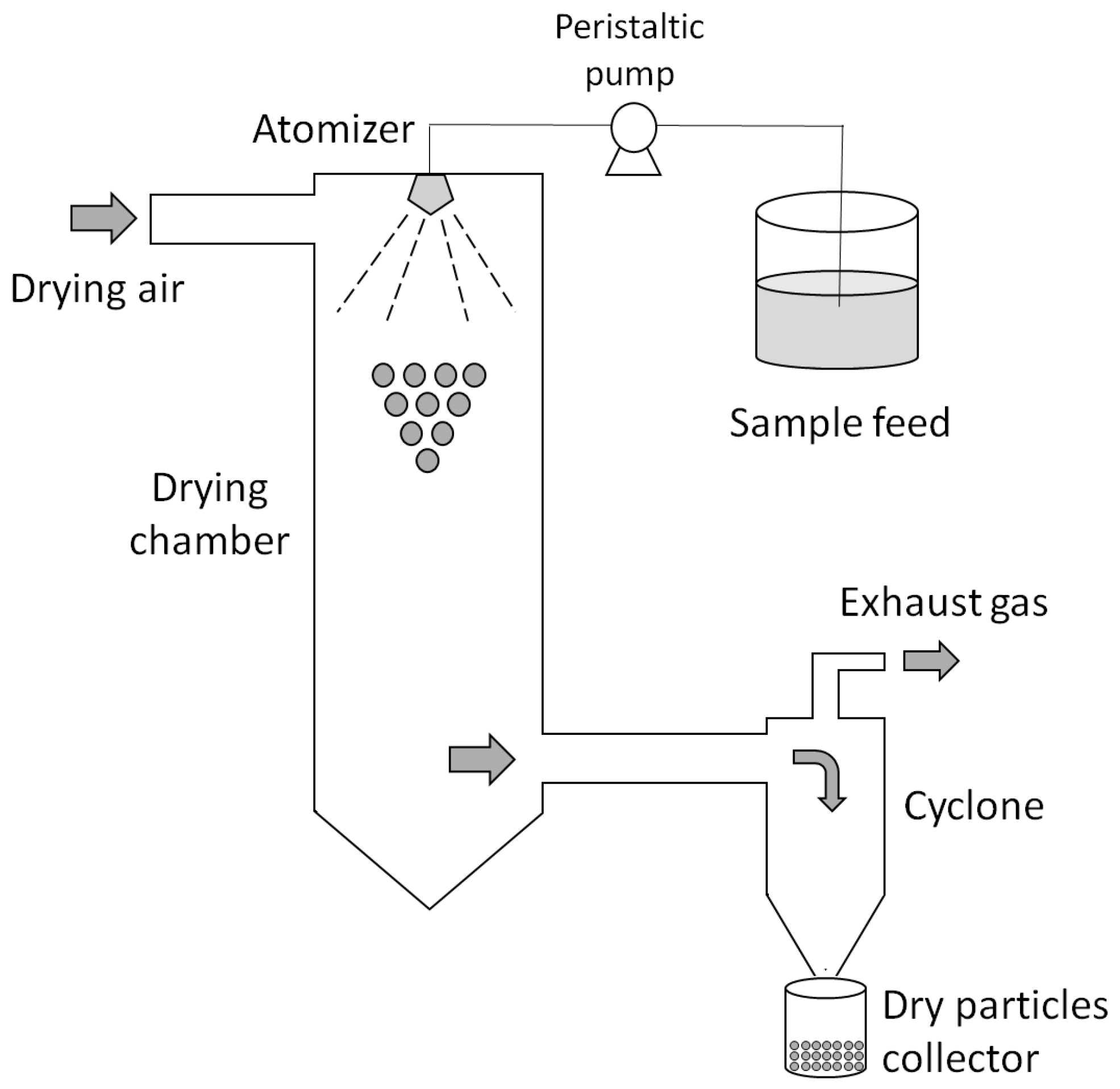

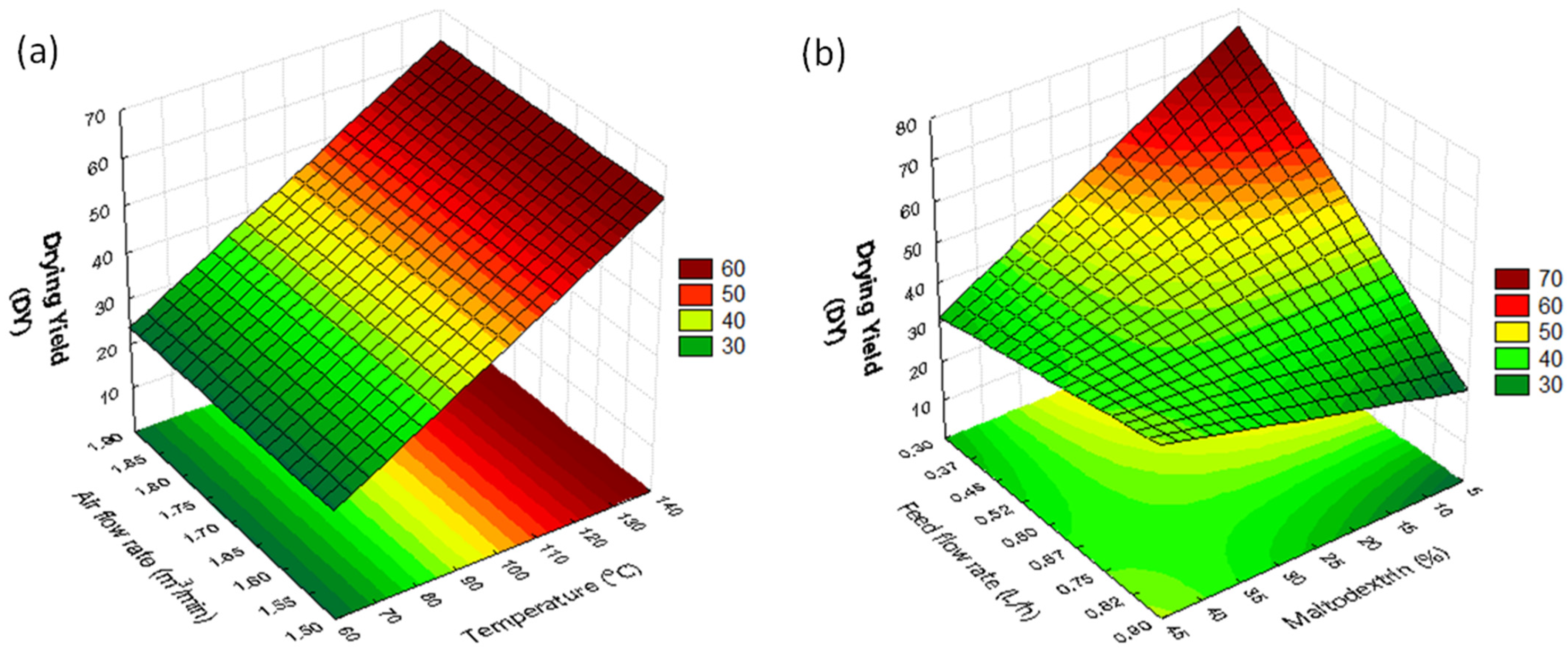


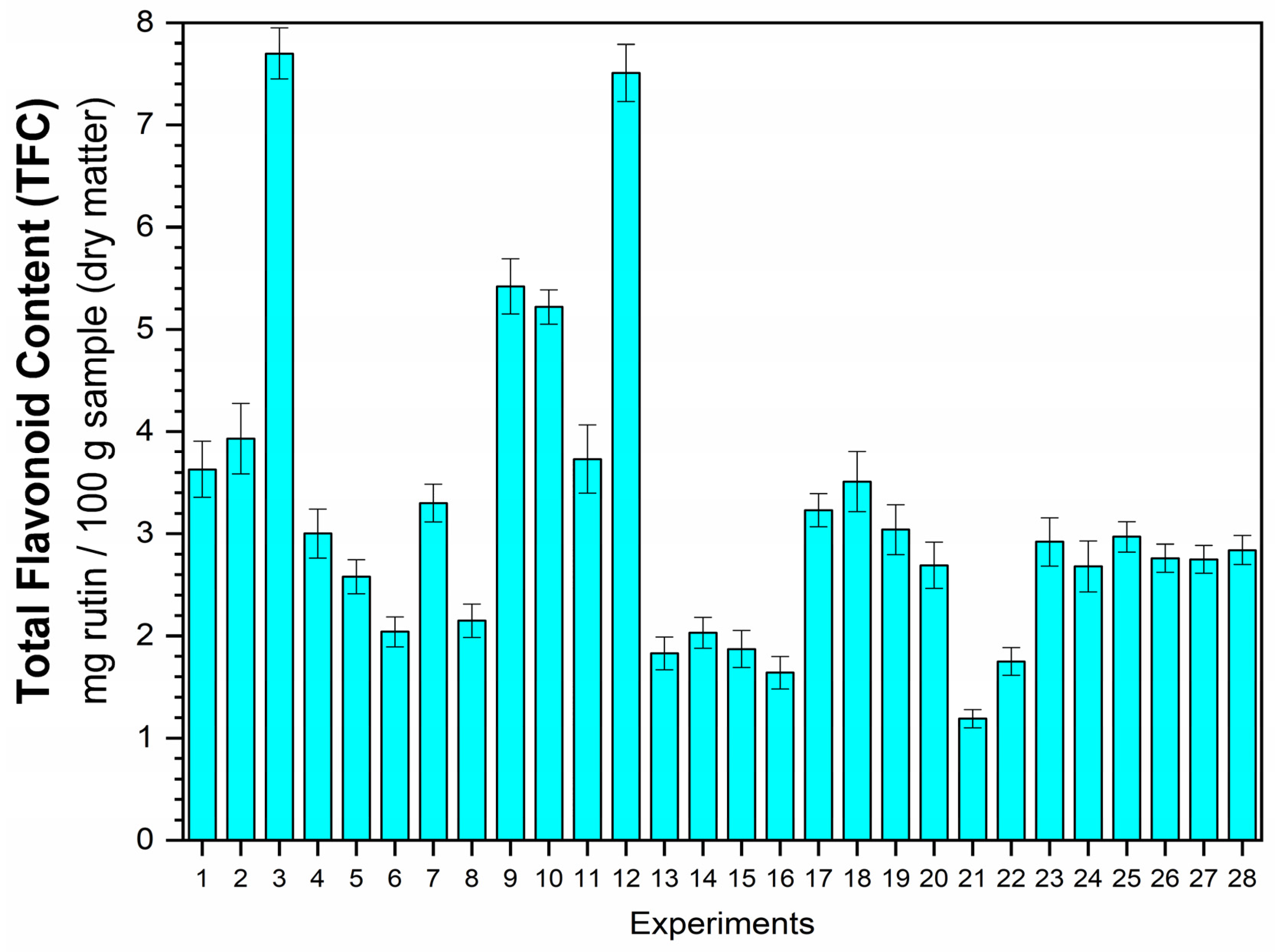
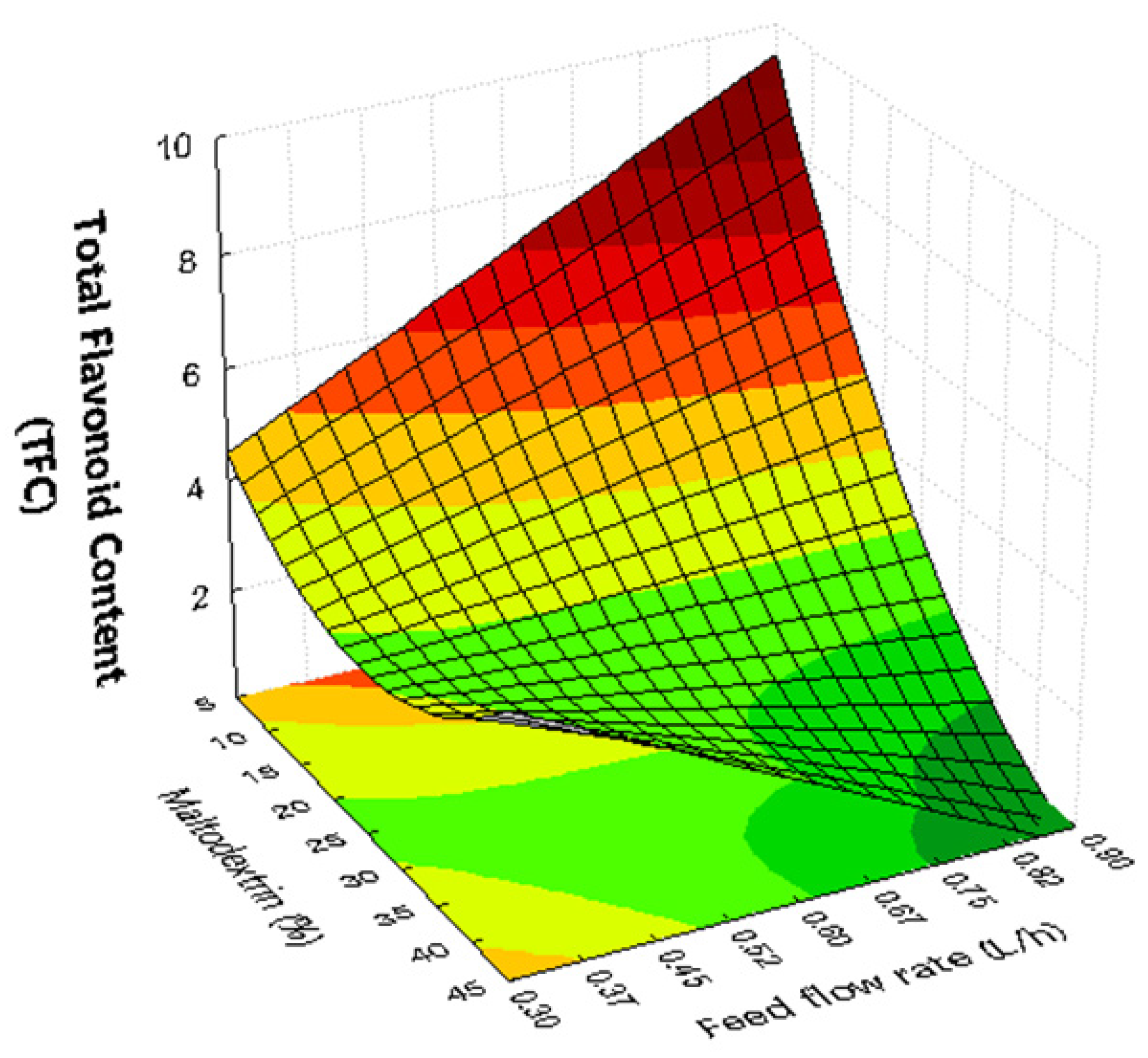


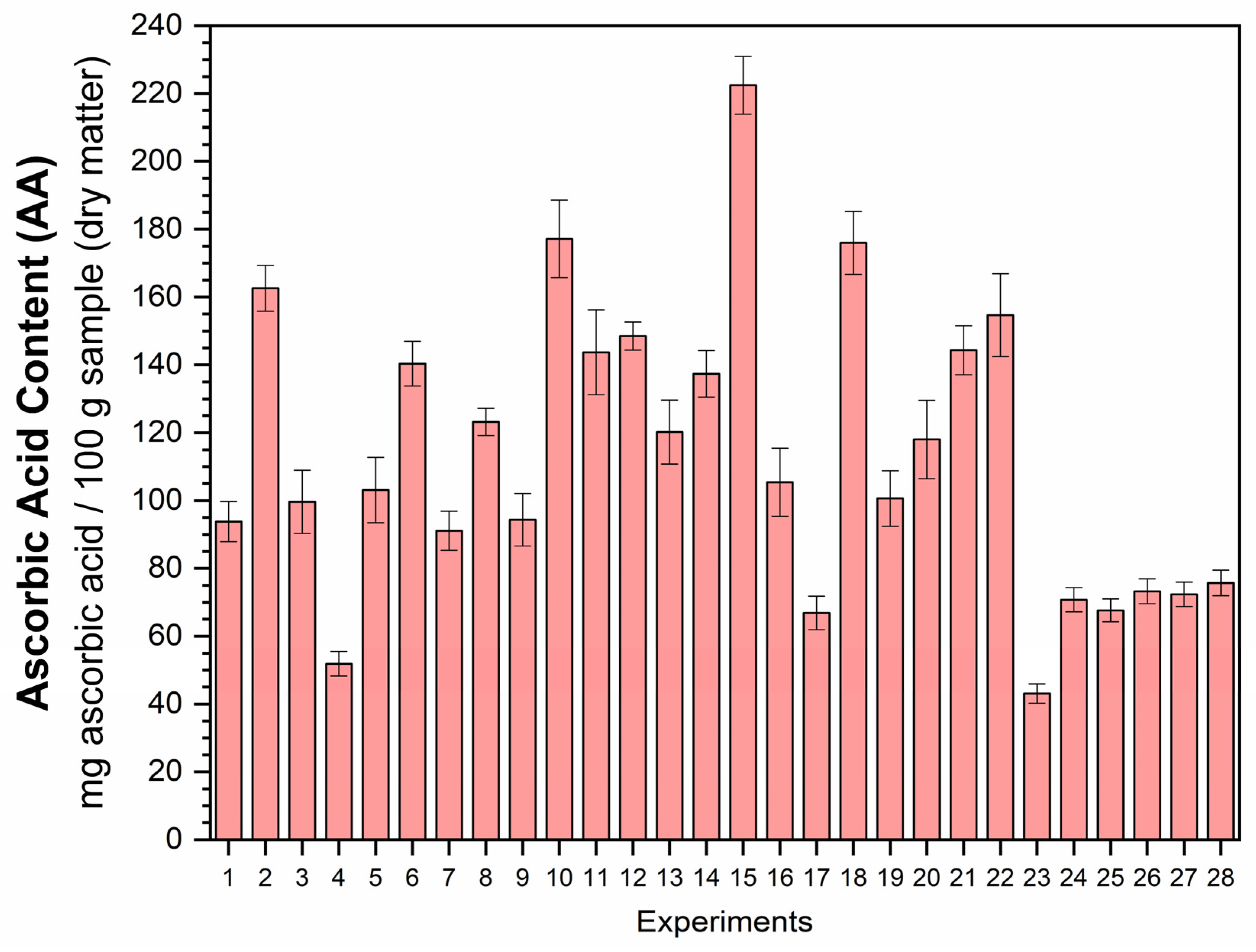
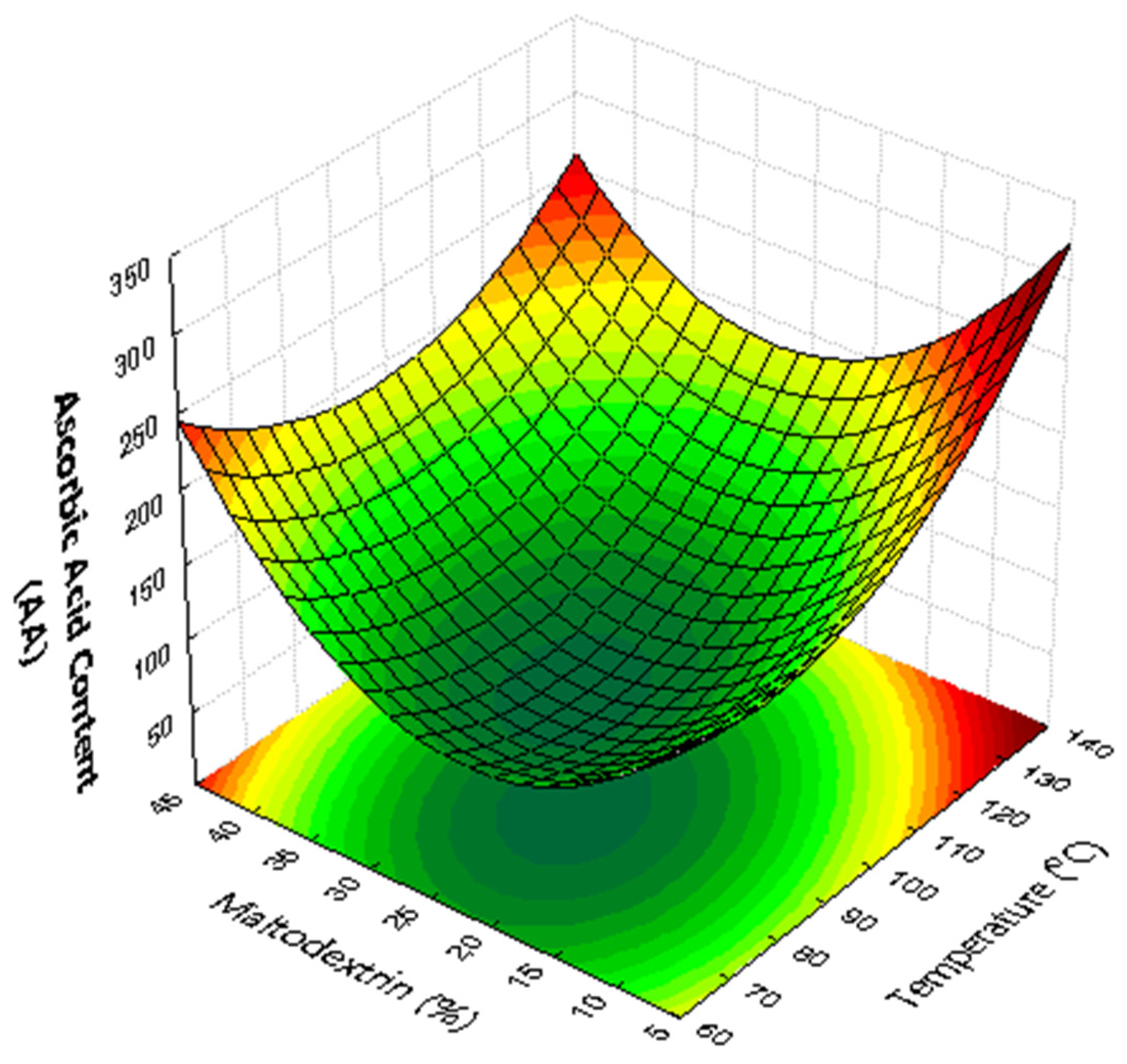

| Independent Variables | −1.6072 | −1 | 0 | +1 | +1.6072 |
|---|---|---|---|---|---|
| Drying air temperature (°C) | 67.9 | 80.0 | 100.0 | 120.0 | 132.1 |
| Drying air flow rate (m3/min) | 1.54 | 1.60 | 1.70 | 1.80 | 1.86 |
| Maltodextrin concentration (%) | 8.9 | 15.0 | 25.0 | 35.0 | 41.1 |
| Jaboticaba feed flow rate (L/h) | 0.36 | 0.45 | 0.6 | 0.75 | 0.84 |
| Exp. | T (°C) | AF (m3/min) | M (%) | FF (L/h) | Final Moisture (%) | Drying Yield (%) |
|---|---|---|---|---|---|---|
| 1 | 80.0 | 1.60 | 15.0 | 0.45 | 3.62 | 58.53 |
| 2 | 120.0 | 1.60 | 15.0 | 0.45 | 1.31 | 62.83 |
| 3 | 80.0 | 1.80 | 15.0 | 0.45 | 3.08 | 51.36 |
| 4 | 120.0 | 1.80 | 15.0 | 0.45 | 2.35 | 55.22 |
| 5 | 80.0 | 1.60 | 35.0 | 0.45 | 2.96 | 48.13 |
| 6 | 120.0 | 1.60 | 35.0 | 0.45 | 1.34 | 44.77 |
| 7 | 80.0 | 1.80 | 35.0 | 0.45 | 3.18 | 38.31 |
| 8 | 120.0 | 1.80 | 35.0 | 0.45 | 0.62 | 58.69 |
| 9 | 80.0 | 1.60 | 15.0 | 0.75 | 4.54 | 39.72 |
| 10 | 120.0 | 1.60 | 15.0 | 0.75 | 2.74 | 57.47 |
| 11 | 80.0 | 1.80 | 15.0 | 0.75 | 4.33 | 39.72 |
| 12 | 120.0 | 1.80 | 15.0 | 0.75 | 2.53 | 37.44 |
| 13 | 80.0 | 1.60 | 35.0 | 0.75 | 4.10 | 23.37 |
| 14 | 120.0 | 1.60 | 35.0 | 0.75 | 1.58 | 53.68 |
| 15 | 80.0 | 1.80 | 35.0 | 0.75 | 3.74 | 19.92 |
| 16 | 120.0 | 1.80 | 35.0 | 0.75 | 1.78 | 56.78 |
| 17 | 67.9 | 1.70 | 25.0 | 0.60 | 3.23 | 22.30 |
| 18 | 132.1 | 1.70 | 25.0 | 0.60 | 1.80 | 56.75 |
| 19 | 100.0 | 1.54 | 25.0 | 0.60 | 2.60 | 35.38 |
| 20 | 100.0 | 1.86 | 25.0 | 0.60 | 1.72 | 48.07 |
| 21 | 100.0 | 1.70 | 8.9 | 0.60 | 4.49 | 47.62 |
| 22 | 100.0 | 1.70 | 41.1 | 0.60 | 2.01 | 45.99 |
| 23 | 100.0 | 1.70 | 25.0 | 0.36 | 1.89 | 51.23 |
| 24 | 100.0 | 1.70 | 25.0 | 0.84 | 2.77 | 35.51 |
| 25 | 100.0 | 1.70 | 25.0 | 0.60 | 3.15 | 42.69 |
| 26 | 100.0 | 1.70 | 25.0 | 0.60 | 2.21 | 41.07 |
| 27 | 100.0 | 1.70 | 25.0 | 0.60 | 3.50 | 49.49 |
| 28 | 100.0 | 1.70 | 25.0 | 0.60 | 2.57 | 39.02 |
Disclaimer/Publisher’s Note: The statements, opinions and data contained in all publications are solely those of the individual author(s) and contributor(s) and not of MDPI and/or the editor(s). MDPI and/or the editor(s) disclaim responsibility for any injury to people or property resulting from any ideas, methods, instructions or products referred to in the content. |
© 2024 by the authors. Licensee MDPI, Basel, Switzerland. This article is an open access article distributed under the terms and conditions of the Creative Commons Attribution (CC BY) license (https://creativecommons.org/licenses/by/4.0/).
Share and Cite
Silva, N.C.; Andrade, G.B.; Barrozo, M.A.S. Spray-Dried Jaboticaba Powder as Food Resource. Resources 2024, 13, 102. https://doi.org/10.3390/resources13080102
Silva NC, Andrade GB, Barrozo MAS. Spray-Dried Jaboticaba Powder as Food Resource. Resources. 2024; 13(8):102. https://doi.org/10.3390/resources13080102
Chicago/Turabian StyleSilva, Neiton C., Gabriela B. Andrade, and Marcos A. S. Barrozo. 2024. "Spray-Dried Jaboticaba Powder as Food Resource" Resources 13, no. 8: 102. https://doi.org/10.3390/resources13080102
APA StyleSilva, N. C., Andrade, G. B., & Barrozo, M. A. S. (2024). Spray-Dried Jaboticaba Powder as Food Resource. Resources, 13(8), 102. https://doi.org/10.3390/resources13080102







